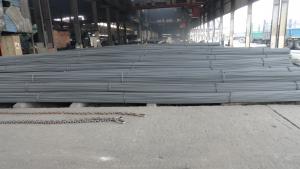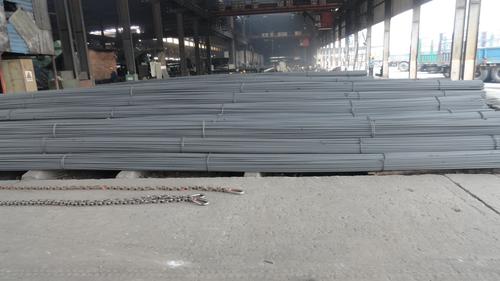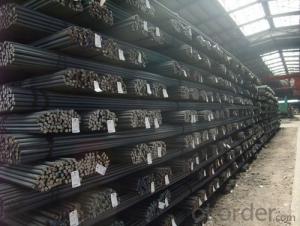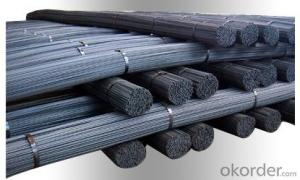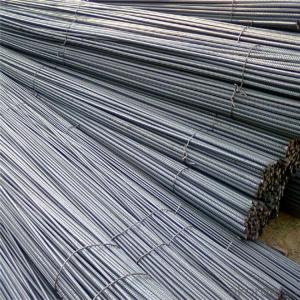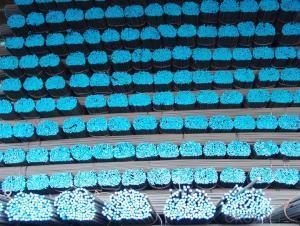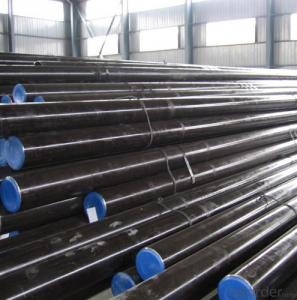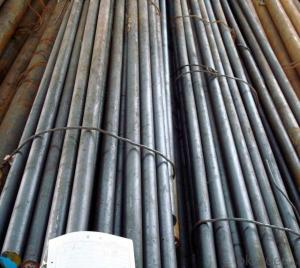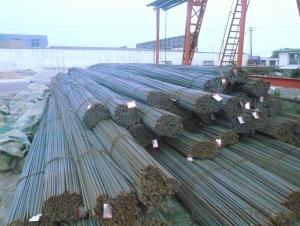Hot Rolled Reinforcing Steel Bar
- Loading Port:
- China Main Port
- Payment Terms:
- TT or LC
- Min Order Qty:
- -
- Supply Capability:
- -
OKorder Service Pledge
OKorder Financial Service
You Might Also Like
Product Description:
OKorder is offering Hot Rolled Reinforcing Steel Bar at great prices with worldwide shipping. Our supplier is a world-class manufacturer of steel, with our products utilized the world over. OKorder annually supplies products to African, South American and Asian markets. We provide quotations within 24 hours of receiving an inquiry and guarantee competitive prices.
Product Applications:
Hot Rolled Reinforcing Steel Bar are ideal for structural applications and are widely used in the construction of buildings and bridges, and the manufacturing, petrochemical, and transportation industries.
Product Advantages:
OKorder's Hot Rolled Reinforcing Steel Bar are durable, strong, and wide variety of sizes.
Main Product Features:
· Premium quality
· Prompt delivery & seaworthy packing (30 days after receiving deposit)
· Can be recycled and reused
· Mill test certification
· Professional Service
· Competitive pricing
Product Specifications:
Manufacture: Hot rolled
Grade: HRB335
Size:8,10, 12, 14, 16, 18, 20, 22, 25, 28, 32mm
Certificates: ISO, SGS, BV, CIQ
Length: 6m – 12m, as per customer request
Packaging: Export packing, nude packing, bundled
Grade | Technical data of the original chemical composition (%) | |||||||
C | Mn | Si | S | P | V | |||
HRB400 | ≤0.25 | ≤1.60 | ≤0.80 | ≤0.045 | ≤0.045 | 0.04-0.12 | ||
Physics capability | ||||||||
Yield Strength(N/cm2) | Tensile Strength(N/cm2) | Elongation (%) | ||||||
≥400 | ≥570 | ≥14 | ||||||
FAQ:
Q1: How soon can we receive the product after purchase?
A1: Within three days of placing an order, we will arrange production. The normal sizes with the normal grade can be produced within one month. The specific shipping date is dependent upon international and government factors, the delivery to international main port about 45-60days.
Q2: How many tons of steel products could be loaded in containers?
A2: Usually the steel products are delivered by bulk vessel because of the large quantity and the freight. However, there are no bulk vessel enter some seaports so that we have to deliver the cargo by containers. The 6m steel product can be loaded in 20FT container, but the quantity is changed according to the size, usually from 18tons to 25tons.
Q3: what is the difference between actual weight and theoretical weight?
A3: All the section steel has two weights: actual weight and theoretical weight. Actual weight is the weighing out when the product delivered from the mill. Theoretical weight is calculated by pieces. The invoice can be based on each of them as your request.
.
Images:
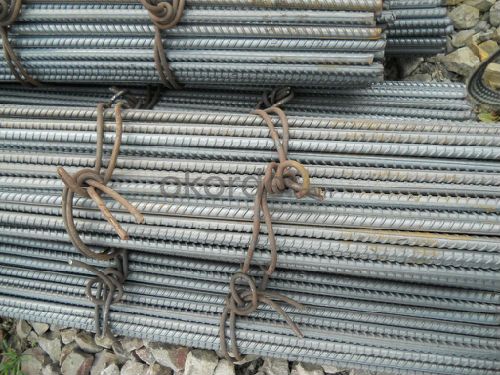
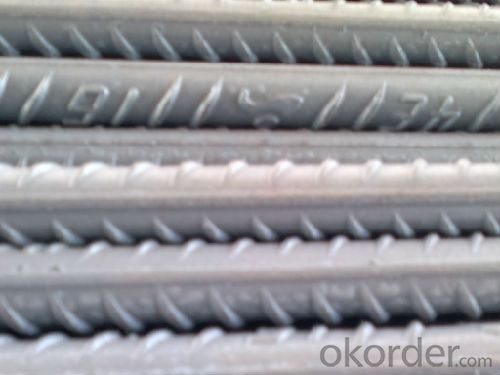
- Q: Can steel rebars be used in modular bridge construction?
- Yes, steel rebars can be used in modular bridge construction. Steel rebars, also known as reinforcing bars, are commonly used in bridge construction to provide reinforcement and strength to the concrete elements. In modular bridge construction, precast concrete elements are used to assemble the bridge components off-site, and steel rebars are embedded within these elements to enhance their structural integrity. The use of steel rebars in modular bridge construction allows for a more efficient and cost-effective construction process. The precast elements can be manufactured in a controlled environment, ensuring high-quality and consistent production. The steel rebars are accurately placed within the elements during the manufacturing process, ensuring proper reinforcement, and eliminating the need for on-site rebar installation. Additionally, steel rebars provide the necessary strength to withstand the loads and stresses that bridges are subjected to. They help in distributing the load evenly and preventing cracking or failure of the concrete elements. The use of steel rebars in modular bridge construction ensures the durability and longevity of the bridge structure. Moreover, steel rebars can be easily integrated into the modular bridge design, allowing for flexibility and customization. Different sizes and configurations of rebars can be used based on the specific requirements of the bridge project, ensuring optimal structural performance. In conclusion, steel rebars are widely used in modular bridge construction as they provide reinforcement, strength, and durability to the precast concrete elements. Their use ensures a cost-effective and efficient construction process while maintaining the structural integrity of the bridge.
- Q: How are steel rebars classified based on their surface patterns?
- Steel rebars are classified based on their surface patterns into three main categories: plain, deformed, and ribbed. Plain rebars have a smooth surface and are primarily used in applications where the concrete needs to slide along the steel surface. Deformed rebars have raised patterns or deformations on their surface, enhancing the bond strength between the steel and the concrete. Ribbed rebars have continuous longitudinal ribs that provide additional surface area for the concrete to adhere to, resulting in better load transfer capabilities.
- Q: What is the tensile strength of different grades of steel rebars?
- The tensile strength of different grades of steel rebars can vary, but generally, it ranges from 400 to 600 megapascals (MPa).
- Q: How are steel rebars classified based on their shape?
- Steel rebars, also known as reinforcement bars, are classified based on their shape into several different types. The most common types of rebars include plain round bars, deformed bars, square bars, and ribbed bars. Plain round bars are the simplest and most commonly used type of rebars. They have a smooth and round surface without any deformations or ribs. These bars are primarily used in applications where the concrete structure requires minimal reinforcement. Deformed bars, on the other hand, have ribs or deformations along their length. These deformations provide better bonding between the steel and the concrete, enhancing the structural integrity and preventing slippage. Deformed bars are classified further based on the pattern and profile of the ribs, such as deformed high yield bars, twisted bars, and TMT (Thermo-Mechanically Treated) bars. Square bars, as the name suggests, have a square cross-section. They are primarily used in applications where the structure requires additional strength and rigidity. Square rebars provide better load distribution and are commonly used in building foundations, columns, and beams. Ribbed bars, also known as deformed square bars, have a square cross-section with ribs or deformations along their length. These ribs enhance the bond between the steel and the concrete, providing better resistance against shear forces and improving the overall structural strength. Ribbed bars are commonly used in reinforced concrete structures, such as bridges, highways, and buildings. In summary, steel rebars are classified based on their shape into plain round bars, deformed bars, square bars, and ribbed bars. Each type of rebar offers unique characteristics and is selected based on the specific requirements and load-bearing capacity of the concrete structure.
- Q: What are the advantages of using epoxy-coated steel rebars?
- Using epoxy-coated steel rebars in construction projects has several advantages. Firstly, the epoxy coating provides excellent corrosion resistance, protecting the rebars from moisture, oxygen, and other environmental elements. This extends their lifespan and enhances the durability of the structure. Secondly, epoxy-coated steel rebars offer improved bonding strength due to their rough surface. This enhances the adhesive properties between the rebar and the concrete, resulting in better load transfer and strengthening the structure. It also reduces cracking and improves the overall structural integrity. Another advantage is their ability to resist chemical attack. The epoxy coating acts as a barrier, preventing direct contact between the steel and chemicals in environments like wastewater treatment plants or industrial facilities. This helps maintain the structural integrity over time. Additionally, epoxy-coated steel rebars are easier to handle and install. The smoothness of the coating reduces friction, making it easier to position and place the rebars accurately. This simplifies the construction process, increases productivity, and reduces labor costs. Lastly, epoxy-coated steel rebars offer aesthetic benefits. The coating can be customized to different colors, allowing for better visual integration with architectural designs. This is particularly useful in projects where the rebars are visible, such as bridges or artistic structures. In conclusion, using epoxy-coated steel rebars provides corrosion resistance, improved bonding strength, chemical resistance, easier handling and installation, and aesthetic benefits. This leads to enhanced durability, reduced maintenance costs, and improved structural performance in construction projects.
- Q: Can steel rebars be used in water treatment facilities?
- Yes, steel rebars can be used in water treatment facilities. Steel rebars, or reinforcing bars, are commonly used in construction projects to strengthen concrete structures. In water treatment facilities, where concrete is used for various structures such as tanks, basins, and pipelines, steel rebars are often incorporated to provide added strength and durability. Water treatment facilities involve the treatment of water to make it safe for consumption or other purposes. Concrete is a preferred material in these facilities due to its ability to withstand the harsh conditions of water treatment processes, such as exposure to chemicals, high temperatures, and pressure. Steel rebars are essential in reinforcing the concrete structures to ensure they can withstand these demanding conditions. The corrosion resistance of steel rebars is a critical factor to consider when using them in water treatment facilities. Since water treatment facilities often involve the use of chemicals and exposure to moisture, it is important to choose rebars that have appropriate corrosion protection. This can be achieved by using stainless steel rebars or by applying protective coatings to the rebars. It is also worth noting that proper design, construction, and maintenance practices are essential in ensuring the long-term performance of steel rebars in water treatment facilities. Adequate cover thickness, concrete quality, and proper installation techniques are important considerations to prevent corrosion and ensure the rebars provide the desired structural integrity. In conclusion, steel rebars can be effectively used in water treatment facilities to reinforce concrete structures and provide the necessary strength and durability. However, it is important to choose corrosion-resistant rebars and adhere to proper design and construction practices to ensure their long-term performance in these facilities.
- Q: How long do steel rebars typically last?
- The lifespan of steel rebars tends to be lengthy, enduring for numerous decades. Several factors come into play when determining the exact duration of their longevity, including the quality of the rebar, the environmental conditions it encounters, and the maintenance practices employed. Generally, steel rebars are designed to possess resistance against corrosion, a key factor influencing their durability. Nevertheless, as time passes, rebars may undergo some corrosion as a result of exposure to moisture, chemicals, or other corrosive substances. This corrosion has the potential to diminish their lifespan. The lifespan of steel rebars can be extended through regular inspections, maintenance, and the application of protective coatings. By providing adequate care, steel rebars can typically remain functional for 30 to 50 years, or possibly even longer.
- Q: Can steel rebars be used in historical building restoration?
- Yes, steel rebars can be used in historical building restoration. Steel rebars provide structural support and reinforcement, making them a suitable choice for strengthening and preserving historical buildings. However, careful consideration should be given to ensure that the use of steel rebars does not compromise the historical integrity and authenticity of the building.
- Q: How are steel rebars tested for quality and compliance?
- Steel rebars are tested for quality and compliance through a series of rigorous methods. These include visual inspection to check for any physical defects, such as surface imperfections or cracks. Additionally, rebars undergo chemical analysis to ensure they meet the required composition and strength specifications. Mechanical testing is conducted to assess the rebars' tensile strength, yield strength, and elongation properties. Another crucial test is the bend test, which evaluates rebars' ability to withstand bending without breaking or cracking. Overall, these various tests help ensure that steel rebars meet the necessary quality and compliance standards for their intended applications.
- Q: How do steel rebars distribute loads in concrete structures?
- The reinforcement and increased tensile strength provided by steel rebars allow for the distribution of loads in concrete structures. A grid-like pattern is typically used to place the rebars in the concrete, creating a network of support throughout the structure. This network helps evenly distribute external loads, such as the weight of the building or the force of an earthquake, preventing the concrete from cracking or failing under stress. To effectively distribute loads, the rebars transfer tensile forces to the surrounding concrete. While concrete is strong in compression, it is weak in tension. The rebars act as reinforcement, resisting the tensile forces and preventing cracks in the concrete. When a load is applied to the structure, the rebars bear a portion of the load and distribute it to adjacent rebars and the surrounding concrete, increasing the overall strength and stability of the structure. The spacing and diameter of the rebars also influence load distribution in concrete structures. Proper spacing ensures even distribution of the load, minimizing the risk of localized stress concentration. The diameter of the rebars is also important, as larger diameter rebars can withstand higher loads and provide more reinforcement. In addition to load distribution, steel rebars help control crack propagation in the concrete. When cracks occur, the rebars transfer stress around the cracked area, preventing them from spreading and maintaining the structural integrity of the concrete. In summary, steel rebars are essential for distributing loads in concrete structures. They provide reinforcement, increase tensile strength, and control crack propagation. Proper placement and sizing of the rebars ensure even load distribution, enhancing the durability and longevity of the structure.
Send your message to us
Hot Rolled Reinforcing Steel Bar
- Loading Port:
- China Main Port
- Payment Terms:
- TT or LC
- Min Order Qty:
- -
- Supply Capability:
- -
OKorder Service Pledge
OKorder Financial Service
Similar products
Hot products
Hot Searches
Related keywords
